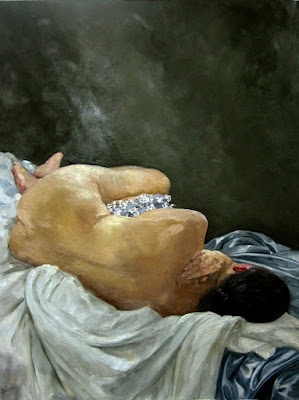What is the ideal of beauty in art? That’s a moving target.
|
Death of Boudicca, by Carol L. Douglas. The sculpted female form is peculiar to our own time in history. Our ancestors would have found it
|
I once had a perfect body, you know. Like most women, I didn’t realize that until I’d lost it to childbearing, cancer and that ultimate indignity, age.
I was reminded of this yesterday when a friend showed me new photos of her daughter, who’s an actress (and a great kid). Her publicity pictures focus on her long, articulated muscles, whippet-thin torso, and delicate fair hair. By contemporary standards, she is physically perfect.
| Longing, by Carol L. Douglas |
“You have to suffer to be beautiful,” my grandmother told me as she tried to tame my frizzy hair into submission. I must have told my own kids that without thinking, because I’ve heard it from their mouths.
“Perfection is ‘lean’ and ‘taut’ and ‘hard’ — like a boy athlete of twenty, a girl gymnast of twelve. What kind of body is that for a man of fifty or a woman of any age? ‘Perfect’? What’s perfect? A black cat on a white cushion, a white cat on a black one… A soft brown woman in a flowery dress… There are a whole lot of ways to be perfect, and not one of them is attained through punishment,” wrote Ursula K. Le Guin in The Wave in the Mind: Talks and Essays on the Writer, the Reader, and the Imagination.
Physical ideals change, but they are reflected by artists. That is their only tangible record. Sleeping Venus may have been painted by a woman (Artemisia Gentileschi) but it suggests all the tropes of female beauty of the time. She is soft, languid, deferential. She is young, because youth has always been associated with beauty.
| Michelle reading, by Carol L. Douglas |
Fashions in beauty were enhanced through whatever panniers, stays or padding were in style at the time. But it wasn’t until the 20th century that women started sculpting our own bodies in earnest. Dieting became a fact of life for most of us. In the 1980s, plastic surgery went mainstream, with women buying dental veneers, breast and buttocks augmentation, nose jobs and eye lifts.
Changes in beauty norms are more pronounced for women, but they’re true for men, too. Historically, the markers of male beauty were money, power and class. These were expressed through clothing, ornamentation, and setting. Sculpted muscles were considered vulgar, reflecting the hard work of the lower classes. The shift to beefcake as beauty corresponds historically with the shift to sculpted bodies in women.
 |
| The Laborer Resting, by Carol L. Douglas |
As always, our ideals about beauty reflect our longing for something we cannot have. Only the wealthy have the leisure and money to afford personal trainers at expensive gyms, chefs to create careful, well-thought-out diet regimens, plastic surgery or tropical tans. The vast majority of us grab breakfast on the run and head in to work, where we sit all day.
“Beauty always has rules. It’s a game. I resent the beauty game when I see it controlled by people who grab fortunes from it and don’t care who they hurt. I hate it when I see it making people so self-dissatisfied that they starve and deform and poison themselves,” wrote Le Guin.
“There’s the ideal beauty of youth and health, which never really changes, and is always true. There’s the ideal beauty of movie stars and advertising models, the beauty-game ideal, which changes its rules all the time and from place to place, and is never entirely true. And there’s an ideal beauty that is harder to define or understand, because it occurs not just in the body but where the body and the spirit meet and define each other.”
